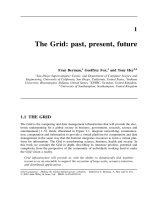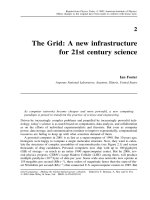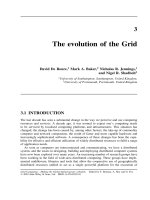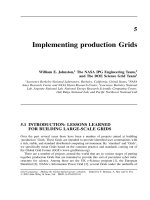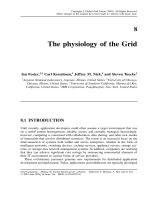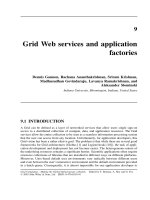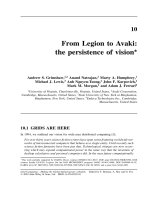Grid Computing P7
Bạn đang xem bản rút gọn của tài liệu. Xem và tải ngay bản đầy đủ của tài liệu tại đây (126.04 KB, 17 trang )
7
Rationale for choosing the Open
Grid Services Architecture
Malcolm Atkinson
National e-Science Centre, Edinburgh, Scotland, United Kingdom
7.1 INTRODUCTION
This chapter presents aspects of the UK e-Science communities’ plans for generic Grid
middleware. In particular, it derives from the discussions of the UK Architecture Task
Force [1].
The UK e-Science Core Programme will focus on architecture and middleware develop-
ment in order to contribute significantly to the emerging Open Grid Services Architecture
(OGSA) [2]. This architecture views Grid technology as a generic integration mechanism
assembled from Grid Services (GS), which are an extension of Web Services (WS) to
comply with additional Grid requirements. The principal extensions from WS to GS are
the management of state, identification, sessions and life cycles and the introduction of a
notification mechanism in conjunction with Grid service data elements (SDE).
The UK e-Science Programme has many pilot projects that require integration technol-
ogy and has an opportunity through its Core Programme to lead these projects towards
adopting OGSA as a common framework. That framework must be suitable, for example,
it must support adequate Grid service interoperability and portability. It must also be
Grid Computing – Making the Global Infrastructure a Reality. Edited by F. Berman, A. Hey and G. Fox
2003 John Wiley & Sons, Ltd ISBN: 0-470-85319-0
200
MALCOLM ATKINSON
populated with services that support commonly required functions, such as authorisation,
accounting and data transformation.
To obtain effective synergy with the international community that is developing Grid
standards and to best serve the United Kingdom’s community of scientists, it is necessary
to focus the United Kingdom’s middleware development resources on a family of GS
for which the United Kingdom is primarily responsible and to deliver their reference
implementations. The UK e-Science and computing science community is well placed to
contribute substantially to structured data integration services [3–15]. Richer information
models should be introduced at the earliest opportunity to progressively approach the
goal of a semantic Grid (see Chapter 17). The UK e-Science community also recognises
an urgent need for accounting mechanisms and has the expertise to develop them in
conjunction with international efforts.
This chapter develops the rationale for working with OGSA and a plan for developing
commonly required middleware complementary to the planned baseline Globus Toolkit
3 provision. It takes the development of services for accessing and integrating structured
data via the Grid as an example and shows how this will map to GS.
7.2 THE SIGNIFICANCE OF DATA FOR e-SCIENCE
The fundamental goal of the e-Science programme is to enable scientists to perform their
science more effectively. The methods and principles of e-Science should become so
pervasive that scientists can use them naturally whenever they are appropriate just as they
use mathematics today. The goal is to arrive at the state where we just say ‘science’.
Just as there are branches of mathematics that support different scientific domains, so
will there be differentiated branches of computation. We are in a pioneering phase, in
which the methods and principles must be elucidated and made accessible and in which
the differentiation of domain requirements must be explored. We are confident that, as
with mathematics, these results will have far wider application than the scientific testing
ground where we are developing them.
The transition that we are catalysing is driven by technology and is largely manifest
in the tsunami of data (see Chapter 36). Detectors and instruments benefit from Moore’s
law, so that in astronomy for instance, the available data is doubling every year [16, 17].
Robotics and nanoengineering accelerates and multiplies the output from laboratories.
For example, the available genetic sequence data is doubling every nine months [16].
The volume of data we can store at a given cost doubles each year. The rate at which we
can move data is doubling every nine months. Mobile sensors, satellites, ocean-exploring
robots, clouds of disposable micro-sensors, personal-health sensors, combined with digital
radio communication are rapidly extending the sources of data.
These changes warrant a change in scientific behaviour. The norm should be to collect,
annotate, curate and share data. This is already a trend in subjects such as large-scale
physics, astronomy, functional genomics and earth sciences. But perhaps it is not yet as
prevalent as it should be. For example, the output of many confocal microscopes, the
raw data from many micro-arrays and the streams of data from automated pathology labs
and digital medical scanners, do not yet appear as a matter of course for scientific use
RATIONALE FOR CHOOSING THE OPEN GRID SERVICES ARCHITECTURE
201
and analysis. It is reasonable to assume that if the benefits of data mining and correlating
data from multiple sources become widely recognised, more data will be available in
shared, often public, repositories.
This wealth of data has enormous potential. Frequently, data contains information rele-
vant to many more topics than the specific science, engineering or medicine that motivated
its original collection and determined its structure. If we are able to compose and study
these large collections of data for correlations and anomalies, they may yield an era of
rapid scientific, technological and medical progress. But discovering the valuable knowl-
edge from the mountains of data is well beyond unaided human capacity. Sophisticated
computational approaches must be developed. Their application will require the skills
of scientists, engineers, computer scientists, statisticians and many other experts. Our
challenge is to enable both the development of the sophisticated computation and the
collaboration of all of those who should steer it. The whole process must be attainable
by the majority of scientists, sustainable within a typical economy and trustable by sci-
entists, politicians and the general public. Developing the computational approaches and
the practices that exploit them will surely be one of the major differentiated domains of
e-Science support.
The challenge of making good use of growing volumes of diverse data is not exclusive
to science and medicine. In government, business, administration, health care, the arts
and humanities, we may expect to see similar challenges and similar advantages in mas-
tering those challenges. Basing decisions, judgements and understanding on reliable tests
against trustworthy data must benefit industrial, commercial, scientific and social goals.
It requires an infrastructure to support the sharing, integration, federation and analysis
of data.
7.3 BUILDING ON AN OGSA PLATFORM
The OGSA emerged contemporaneously with the UK e-Science review of architecture
and was a major and welcome influence. OGSA is the product of combining the flexible,
dynamically bound integration architecture of WS with the scalable distributed architecture
of the Grid. As both are still evolving rapidly, discussion must be hedged with the caveat
that significant changes to OGSA’s definition will have occurred by the time this chapter
is read.
OGSA is well described in other chapters of this book (see Chapter 8) and has been the
subject of several reviews, for example, References [18, 19]. It is considered as the basis
for a data Grid (see Chapter 15) and is expected to emerge as a substantial advance over
the existing Globus Toolkit (GT2) and as the basis for a widely adopted Grid standard.
7.3.1 Web services
Web Services are an emerging integration architecture designed to allow independently
operated information systems to intercommunicate. Their definition is the subject of W3C-
standards processes in which major companies, for example, IBM, Oracle, Microsoft and
SUN, are participating actively. WS are described well in Reference [20], which offers
the following definition:
202
MALCOLM ATKINSON
‘A Web service is a platform and implementation independent software component that
can be
•
described using a service description language,
•
published to a registry of services,
•
discovered through a standard mechanism (at run time or design time),
•
invoked through a declared Application Programming Interface (API), usually over
anetwork,
•
composed with other services.’
WS are of interest to the e-Science community on two counts:
1. Their function of interconnecting information systems is similar to the Grid’s intended
function. Such interconnection is a common requirement as scientific systems are often
composed using many existing components and systems.
2. The support of companies for Web services standards will deliver description lan-
guages, platforms, common services and software development tools. These will enable
rapid development of Grid services and applications by providing a standard frame-
work for describing and composing Web services and Grid services. They will also
facilitate the commercialisation of the products from e-Science research.
An important feature of WS is the emergence of languages for describing aspects of the
components they integrate that are independent from the implementation and platform
technologies. They draw heavily on the power of XML Schema. For example, the Web
Services Description Language (WSDL) is used to describe the function and interfaces
(portTypes) of Web services and the Web Services Inspection Language (WSIL) is used
to support simple registration and discovery systems. Simple Object Access Protocol
(SOAP) is a common denominator interconnection language that transmits structured
data across representational boundaries. There is currently considerable activity proposing
revisions of these standards and additional languages for describing the integration and the
coordination of WS, for describing quality-of-service properties and for extending Web
service semantics to incorporate state, more sophisticated types for ports and transactions.
It is uncertain what will emerge, though it is clear that the already strong support for
distributed system integration will be strengthened. This will be useful for many of the
integration tasks required to support e-Science.
Inevitably, the products lag behind the aspirations of the standards proposals and vary
significantly. Nevertheless, they frequently include sophisticated platforms to support
operations combined with powerful development tools. It is important that developers
of e-Science applications take advantage of these. Consequently, the integration archi-
tectures used by e-Science should remain compatible with Web services and e-Science
developers should consider carefully before they develop alternatives.
7.3.2 The Open Grid Services Architecture
As other chapters describe OGSA (see Chapter 8), it receives only minimal description
here, mainly to introduce vocabulary for later sections. A system compliant with OGSA
RATIONALE FOR CHOOSING THE OPEN GRID SERVICES ARCHITECTURE
203
is built by composing GS. Each Grid service is also a Web service and is described by
WSDL. Certain extensions to WSDL are proposed to allow Grid-inspired properties to
be described, and these may be adopted for wider use in forthcoming standards. This
extended version of WSDL is called Grid Services Description Language (GSDL).
To be a Grid service the component must implement certain portTypes, must comply
with certain lifetime management requirements and must be uniquely identifiable by a
Grid Service Handle (GSH) throughout its lifetime. The lifetime management includes
a soft-state model to limit commitments, to avoid permanent resource loss when partial
failures occur and to guarantee autonomy. In addition, evolution of interfaces and function
are supported via the Grid Service Record (GSR). This is obtainable via a mapping from a
GSH, and has a time to live so that contracts that use it must be renewed. These properties
are important to support long-running scalable distributed systems.
A Grid service may present some of its properties via SDE. These SDE may be static
or dynamic. Those that are static are invariant for the lifetime of the Grid service they
describe, and so may also be available via an encoding in an extension of WSDL in
the GSR. Those that are dynamic present aspects of a Grid service’s state. The SDE
may be used for introspection, for example, by tools that generate glue code, and for
monitoring to support functions such as performance and progress analysis, fault diagnosis
and accounting. The SDE are described by XML Schema and may be queried by a simple
tag, by a value pair model and by more advanced query languages. The values may not
be stored as XML but synthesised on demand.
An event notification, publish and subscribe, mechanism is supported. This is associated
with the SDE, so that the query languages may be used to specify interest.
The functions supported through the mandatory portTypes include authentication and
registration/discovery.
7.4 CASE FOR OGSA
The authors of OGSA [2] expect the first implementation, Globus Toolkit 3 (GT3), to
faithfully reproduce the semantics and the APIs of the current GT2, in order to min-
imise the perturbation of current projects. However, the influence of the thinking and
the industrial momentum behind WS, and the need to achieve regularities that can be
exploited by tools, will surely provoke profound changes in Grid implementations of the
future. Indeed, OGSA is perceived as a good opportunity to restructure and re-engineer
the Globus foundation technology. This will almost certainly be beneficial, but it will also
surely engender semantically significant changes.
Therefore, because of the investment in existing Grid technology (e.g. GT2) by many
application projects, the case for a major change, as is envisaged with OGSA, has to
be compelling. The arguments for adopting OGSA as the direction in which to focus
the development of future Grid technology concern three factors: politics, commerce
and technology.
The political case for OGSA is that it brings together the efforts of the e-Science pio-
neers and the major software companies. This is essential for achieving widely accepted
204
MALCOLM ATKINSON
standards and the investment to build and sustain high-quality, dependable Grid infras-
tructure. Only with the backing of major companies will we meet the challenges of
•
installing widespread support in the network and the operating system infrastructures,
•
developing acceptance of general mechanisms for interconnection across boundaries
between different authorities and
•
obtaining interworking agreements between nations permitting the exchange of signif-
icant data via the Grid.
The companies will expect from the e-Science community a contribution to the political
effort particularly through compelling demonstrations.
The commercial case is the route to a sustainable Grid infrastructure and adequate
Grid programming tools, both of which are missing for the Grid at present because the
e-Science community’s resources are puny compared to the demands of building and
sustaining comprehensive infrastructure and tool sets. If convergence can be achieved
between the technology used in commercial applications for distributed software integra-
tion and that used for scientific applications, then a common integration platform can be
jointly constructed and jointly maintained. As commerce is ineluctably much larger than
the science base alone, this amortises those costs over a much larger community. Com-
merce depends on rapid deployment and efficient use of many application developers who
are rarely experts in distributed systems. Yet it also depends on a growing number of ever
more sophisticated distributed systems. It therefore has strong incentives to build tool sets
and encapsulated services that would also benefit scientists if we share infrastructure, as
we do today for computers, operating systems, compilers and network Internet protocol
(IP) stacks.
A further commercial advantage emerges from the proposed convergence. It will be
easier to rapidly transfer e-Science techniques to commerce and industry. Using a common
platform, companies will have less novel technology to learn about, and therefore less
assimilation costs and risks when they take up the products of e-Science research.
The technological case for OGSA is largely concerned with software engineering
issues. The present set of components provided by the Grid has little structure to guide
the application developers. This lack of explicit structure may also increase the costs of
maintaining and extending the existing Grid infrastructure.
The discipline of defining Grid services in terms of a language (GSDL) and of impos-
ing a set of common requirements on each Grid service should significantly improve the
ease and the accuracy with which components can be composed. Those same disciplines
will help Grid service developers to think about relevant issues and to deliver depend-
able components. We expect significant families of GS that adopt additional constraints
on their definition and address a particular domain. Such families will have improved
compositional properties, and tools that exploit these will be a natural adjunct.
Dynamic binding and rebinding with soft state are necessary for large-scale, long-
running systems that are also flexible and evolvable. The common infrastructure and
disciplines will be an appropriate foundation from which to develop
